Everything you need to know about Scotland's West Highland Way
This article contains affiliate links. We may earn a small commission on items purchased through this article, but that does not affect our editorial judgement.
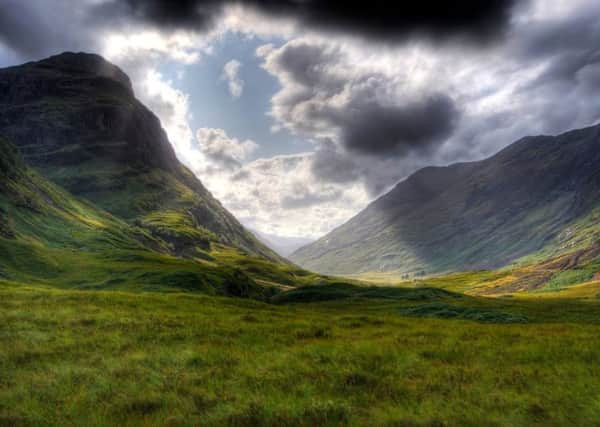

The 154km (just under 96 mile) path was Scotland’s first long distance route and is a fabulous way to discover the Scottish Highlands. Slighe na Gàidhealtachd an Iar
(Gaelic for Route of the West Highland) winds its way north along the west coast, offering spectacular views and memories that will last a lifetime.
The Route
Advertisement
Hide Ad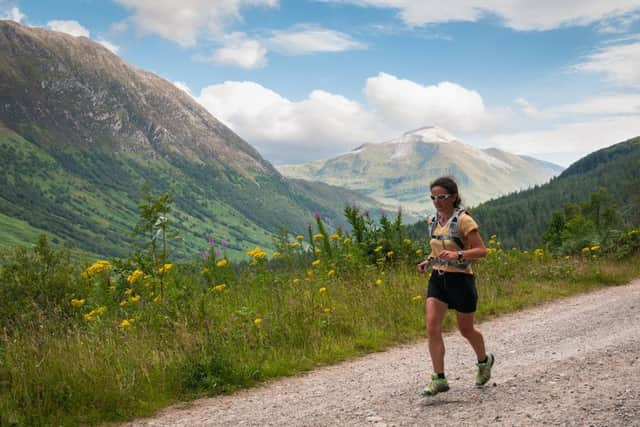

The West Highland Way is usually traversed from south to north, with the softer lands and valleys of the Lowlands giving way to the hilly terrain and munros of the Highlands.
The reasons for this are that it is usually easier (and cheaper) to travel to Glasgow and it also gives the walkers time to get used to the demands of the walk before the moorlands and smoother landscapes around Glasgow gives way to the tougher terrain of the Loch Lomond & the Trossachs National Park.
The route is usually broken down into 8 stages, and can be completed in seven to eight days, though it is entirely up to the traveller, as more experienced walkers have been known to do it in five or six days.
Most agree though that as it is the sights and experiences of the journey that matter, so a slower meander may provide a more enjoyable trip.
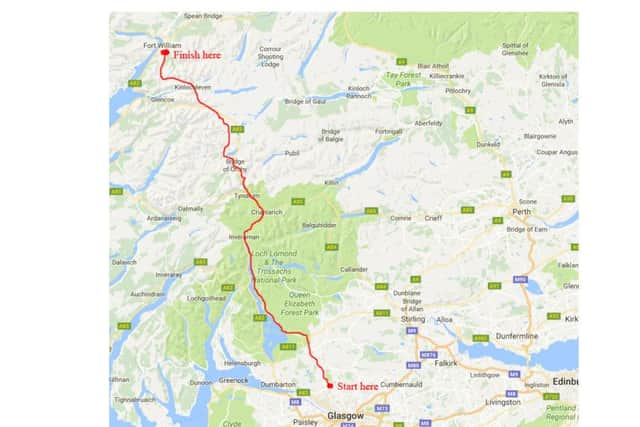

The route begins in Milngavie, going through Mugdock Country Park, along the shores of Loch Lomond, past Ben Lomond, across Rannoch Moor, and past the pyramid shape of the mountain Buachaille Etive Mor to Glen Coe. It then climbs the Devil’s Staircase, which is the highest point along the way, at 1850 ft, before descending to cross the River Leven at Kinlochleven, entering Lairigmor and Glen Nevis, and finishing at Gordon Square in Fort William.
Route recommended by www.walkhighlands.co.uk
Stage 1: Milngavie to Drymen - this part of the route begins at Milngavie, which is accessible by train from Glasgow Central Station (or by walking following the Kelvin Walkway) and spans 19km to Drymen. Time: 5 to 6 hours to complete. Distance: 19km Notable sights - Mugdock Castle, Mugdock Country Park, the Campsie Fells, Drumgoyne and Glengoyne Distillery.
Advertisement
Hide AdStage 2: Drymen to Rowardennan - the second part of the Way sees walkers setting out from Drymen, heading through Balmaha and skirting along the east shore of Loch Lomond to Rowardennan. Time: 6 - 7 hours to complete Distance: 23km. Notable sights - Loch Lomond, Rowardennan Forest, Conic Hill and Garadhban Forest.
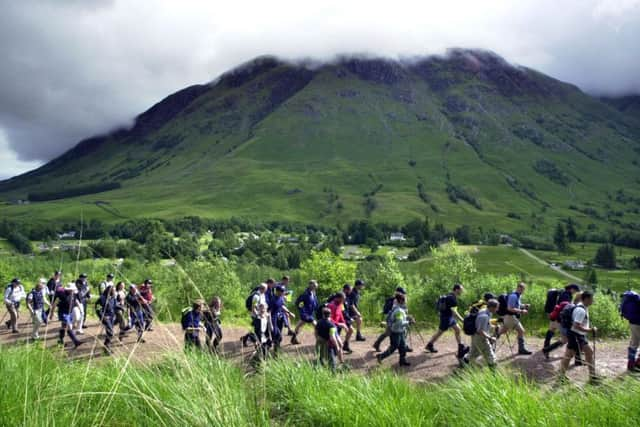

Stage 3: Rowardennan to Inverarnan - the third part takes in sights of Ben Lomond, again following the east shore of Loch Lomond, through to Inverarnan. Time: 6 - 7 hours Distance: 22km long Notable sights - Ben Lomond, Loch Lomond and Rob Roy’s cave.
Advertisement
Hide AdStage 4: Inverarnan to Tyndrum - From Tyndrum the route passes the village of Crianlarich before it reaches Tyndrum. Distance: 19km Time: 5 - 6 hours
Stage 5: Tyndrum to Inveroran - This part then takes you over towards the Bridge of Orchy to Inveroran. Distance: 14km Time: 4 - 5 hours Notable sights: Rannoch Moor
Stage 6: Inveroran to Kings House - The Way then passes through Inveroran and onto Kings House. Distance: 15.5km Time: 4 - 5 hours Notable sights - Loch Tulla and Glencoe
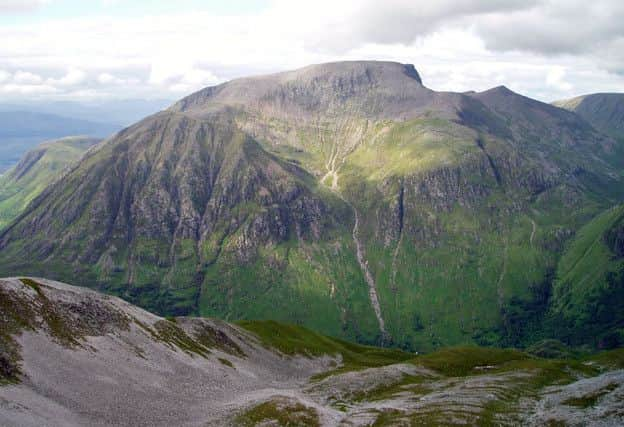

Stage 7: Kings House to Kinlochleven - From Kings House the beauty of Glencoe leads onto the town of Kinlochleven. Distance: 14km Time: 4 - 5 hours Notable sights - Glencoe
Stage 8: Kinlochleven to Fort William - The final stage heads out from Kinloheven and finishes in Fort William. Distance: 24.5km Time: 6 - 7 hours Notable sights - Ben Nevis
If you want to extend your hike
The Great Glen Way - The Great Glen Way takes your finishing point at Fort William and extends it on to the east coast and Inverness for a further 73 miles and passes Fort Augustus and Drumnadrochit and offers stunning views of Loch Ness.
Advertisement
Hide AdBen Nevis - At 4409 feet Ben Nevis is Britain’s highest mountain, for those hardy souls looking for a further challenge after completing the West Highland Way, then Beinn Nibheis is exactly what you are looking for and offers hikers and climbers alike their own challenges to reach its summit.
Things you should know before you go


Peak season begins around March and continues through into September, and the routes fill up fast. It’s important to try to plan ahead and though you can camp along the majority of the route should you be wishing to stay in a designated camping area, at a hostel or one of the hotels along the way it is advisable to book in advance.
Advertisement
Hide AdLater in the season (from late summer to autumn) our infamous population of national pests (midges) will be become an irritating problem, it is advised you invest in Avon Skin So Soft or some other type of midge repellant.
Around 85,000 walkers use the route every year, with approximately 30,000 completing it in its 96-mile entirety. Be prepared for the route to be quite busy at the height of summer.
You won’t need any specialist equipment to tackle the West Highland Way, but we’d recommend taking blister plasters; plenty of water and high-energy snacks like dried fruit, chocolate and bananas. Wear layers of clothing that can be added or removed as the weather sees fit, and sunscreen and sunglasses are just as important as hats, fleeces and gloves.
Comfortable walking boots are essential, as is a map of the West Highland Way and a whistle to alert others if you run into problems - there is no mobile phone signal for large stretches of the walk so don’t rely on your phone for route maps, info or keeping in touch. Take a torch with spare batteries, and a small first aid kit in a waterproof container with band-aids, painkillers, a triangular bandage which can be used to hold dressings or splints or can be used to make a sling, an elastic knee support, sterile dressings for wounds, antispetic cream, antiseptic wipes, adhesive tape, safety pins, scissors and tweezers, plus Dextrose energy tablets.
Food and Drink
Though it will be important to have your provisions sorted before heading off, there are plenty of amazing food and drink stops along the way.
Whisky: Not only will you be able to start with a dram at the excellent Glengoyne Distillery (£9 per person for the basic distillery tour) which is located at the foot of Dumgoyne near to where you set off, you’ll also be able to finish with one too at the equally great (though slightly more rustic) Ben Nevis Distillery (£5 per person for the basic distillery tour).
Advertisement
Hide AdBeer: There are some fantastic pubs along the route and plenty of excuses to socialise with fellow walkers and travellers. Foremost among these is the Drovers Innwhich is well known for its live music, great food and fantastic drink selection. You can also visit the oldest registered licensed pub in Scotland The Clachan Inn on the beautiful village square of Drymen, which has been serving guests since 1734.
Food: The Oak Tree Inn not only offers some delicious fare, it also has a coffee shop and ice-cream parlour, while for those looking for something a little more luxurious can find some stunning Scottish dishes at the Bridge of Orky Hotel.
Advertisement
Hide AdThose seeking some excellent examples of how good Scottish seafood can be, should check out the Loch Leven Seafood Café and for as reward after all that walking the award-winning Lime Tree restaurant in Fort William is the perfect place to finish.
Accommodation
There is a wide range of accommodation along the route including bothies, bunkhouses, hostels, B&Bs, guest houses and hotels. Here are just a few:
The Inversnaid Bunkhouse is a converted church on the eastern shore of Loch Lomond, 800 metres from the Way.
Drymen Camping is a good stop for the first night of the walk, being 11 miles from Milngavie. They have two wigwams that sleep up to six as well as pitches for your tent, and do a full Scottish breakfast to fuel the day’s walking ahead.
The Victorian three-star Crianlarich Hotel is popular with West Highland Way walkers and has good reviews on Trip Advisor.
Blackwater Hostel and Campsite near Glen Coe has 39 beds in ten en suite rooms and 30 camping pitches in the heart of Kinlochleven.
Advertisement
Hide AdWild Camping is allowed along the Way, under the Scottish Outdoor Access Code, camping must be lightweight, done in small numbers and only for two or three nights in any one place.
What the bloggers say
American writer Doug Schnitzspahn writes: “It cuts through the Highlands that kept out the Romans in ancient times and have helped the Scots retain their national character throughout history.
Advertisement
Hide Ad“The trail can feel big and windswept at times, taking in the rocky peaks and rolling grasses of Glen Coe and climbing the Devil’s Staircase path on the Aonach Eagach ridge. But the route also takes in more subtle beauty, including the bogs of Rannoch Moor and the shores of bucolic Loch Lomond.”
DOWNLOAD THE SCOTSMAN APP ON ITUNES OR GOOGLE PLAY